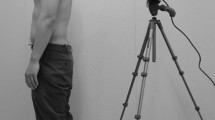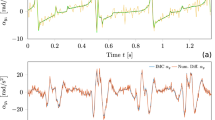Abstract
This paper presents an inertial based sensing system for real-time three-dimensional measurement of human spinal motion, in a portable and non-invasive manner. Applications of the proposed system range from diagnosis of spine injury to postural monitoring, on-field as well as in the lab setting. The system is comprised of three inertial measurement sensors, respectively attached and calibrated to the head, torso and hips, based on the subject’s anatomical planes. Sensor output is transformed into meaningful clinical parameters of rotation (twist), flexion-extension and lateral bending of each body segment, with respect to calibrated global reference space. Modeling the spine as a compound flexible pole model allows dynamic measurement of three-dimensional spine motion, which can be animated and monitored in real-time using our interactive GUI. The accuracy of the proposed sensing system has been verified with subject trials using a VICON optical motion measurement system. Experimental results indicate an error of less than 3.1° in segment orientation tracking.






















Similar content being viewed by others
References
Bachmann E, McKinney D, McGhee R, Yun X, Zyda M (2003) Design and implementation of MARG sensors for 3-DOF orientation measurement of rigid bodies. In: Proceedings of IEEE Int Conf on robotics and automation, Taipei, Taiwan, pp 1171–1178
Balan A, Sigal L, Black M (2005) A quantitative evaluation of video-based 3D person tracking. In: Proceedings of IEEE Int Workshop on visual surveillance and performance evaluation of tracking and surveillance, Beijing, China, pp 349–356
Barshan B, Durrant-Whyte H (1995) Inertial navigation systems for mobile robots. IEEE Trans Rob Autom 11(3):328–342
Bonato P (2005) Advances in wearable technology and applications in physical medicine and rehabilitation. J Neuro Eng Rehabil 2:2
Cooper R, Cardan C, Allen R (2001) Computer visualization of the moving human lumbar spine. Comput Biol and Med 31:451–469
Crawford NR, Yamaguchi GT, Dickman CA (1999) A new technique for determining 3-D joint angles: the tilt/twist method. Clin Biomech 14:153–165
Foxlin E (1996) Inertial head tracker sensor fusion by a complementary separate bias Kalman filter. In: Proceedings of IEEE virtual reality annual Int symposium, Santa Clara, CA, pp 185–195
Jovanov E, Milenkovic A, Otto C, de Groen P (2005) A wireless body area network of intelligent motion sensors for computer assisted physical rehabilitation. J Neuro Eng Rehab 2(6): 1–10
Klein P, Broers C, Feipel V, Salvia P, Van Geyt B, Dugailly PM, Rooze M (2003) Global 3D head-trunk kinematics during cervical spine manipulation at different levels. Clin Biomech 18:827–831
Lee RYW, Laprade J, Fung EHK (2003) A real-time gyroscopic system for 3-D measurement of lumbar spine motion. Med Eng Phys 25:817–824
Luinge HJ, Veltink PH (2005) Measuring orientation of human body segments using miniature gyroscopes and accelerometers. Med Biol Eng Comput 43:273–282
Luinge HJ, Veltink PH, Baten CTM (1999) Estimating orientation with gyroscopes and accelerometers. Technol Health Care 7:455–459
Mayagoitia RE, Nene AV, Veltink PH (2002) Accelerometer and rate gyroscope measurement of kinematics: an inexpensive alternative to motion analysis systems. J Biomech 35(4):537–542
Rehbinder H, Hu X (2004) Drift free attitude estimation for accelerated rigid bodies. Automatica 40:653–659
Roetenburg D, Luinge HJ, Baten CTM, Veltink PH (2005) Compensation of magnetic disturbances improves inertial and magnetic sensing of human body segment orientation. IEEE Trans Neural Syst Rehab Eng 13(3):395–405
Williamson R, Andrews BJ (2001) Detecting absolute human knee angle and angular velocity using accelerometers and rate gyroscopes. Med Biol Eng Comput 39(3):294–302
Zheng Y, Nixon M, Allen R (2003) Lumbar spine visualization based on kinematic analysis from videofluoroscopic imaging. Med Eng Phys 25:171–179
Zhou H, Hu H, Tao Y (2006) Inertial measurements of upper limb motion. Med Biol Eng Comput 44:479–487
Acknowledgments
This work was supported by grants from the Industrial Partnerships program of the British Columbia Innovation Council and the Idea to Innovation (I2I) program of the Natural Sciences and Engineering Research Council of Canada (NSERC). The authors would like to thank Dr. Naznin Virji-Babul of the Centre for Human Movement Analysis (CHUMA) in the Queen Alexandra Centre for Children’s Health for giving them access to the VICON system, and Dr. Timothy Inglis of the University of British Columbia and Jung Keun Lee of the University of Victoria for their constructive comments. They also thank Ed Haslam of the University of Victoria for providing the necessary hardware modification of the VICON system.
Author information
Authors and Affiliations
Corresponding author
Rights and permissions
About this article
Cite this article
Goodvin, C., Park, E.J., Huang, K. et al. Development of a real-time three-dimensional spinal motion measurement system for clinical practice. Med Bio Eng Comput 44, 1061–1075 (2006). https://doi.org/10.1007/s11517-006-0132-3
Received:
Accepted:
Published:
Issue Date:
DOI: https://doi.org/10.1007/s11517-006-0132-3





